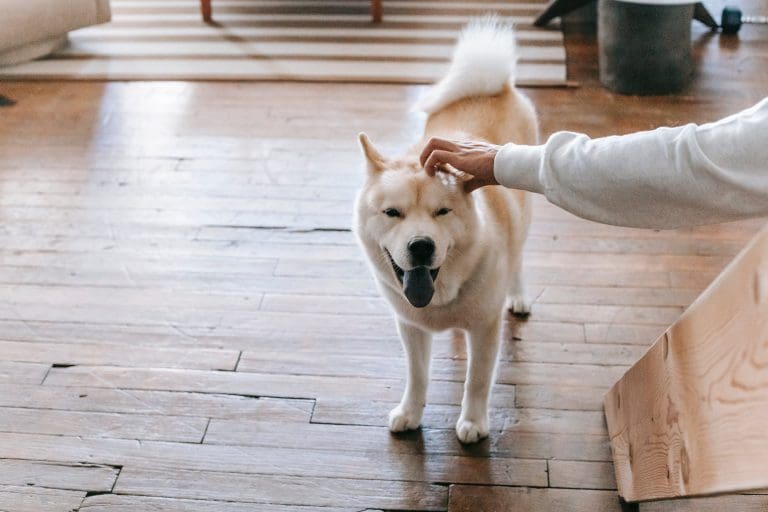Why Does My Dog Move From Spot To Spot While Sleeping?
Post Date:
December 10, 2024
(Date Last Modified: December 13, 2024)
Many dog owners notice their furry companions shifting positions or relocating while they sleep. This behavior can be puzzling and may leave you wondering what goes on in your dog’s mind during those restless moments. Understanding why your dog moves from spot to spot can provide insights into their comfort, instincts, and overall well-being.
Stages of Dog Sleep
Dogs, like humans, experience various stages of sleep, including light sleep, deep sleep, and REM (rapid eye movement) sleep, where dreaming occurs. During these stages, it’s common for dogs to exhibit behaviors such as moving, twitching, or even vocalizing. If you’ve seen your dog paws at the air or wag their tail while snoozing, you might have witnessed them dreaming—perhaps chasing a squirrel or playing with a favorite toy. This is a natural part of their sleep cycle and generally doesn’t indicate any issues.
Comfort and Instincts
Frequent changes in sleeping spots can stem from your dog’s instinctive drive to find the most comfortable position. If they feel a draft or if the surface is too hard or cold, they may instinctively seek a more suitable location. This behavior is especially common in older dogs or those with joint issues, as they may need to adjust their position to alleviate discomfort.
Environmental Influences
Dogs are sensitive creatures, and changes in their environment can impact their sleep. New sounds, scents, or temperature shifts may prompt your dog to move around in search of a more suitable sleeping area. For instance, if a window is open and a chilly breeze flows through, your dog might shift to a warmer spot. Maintaining a stable and comfortable environment can help minimize unnecessary movements.
Social Nature and Companionship
As pack animals, dogs are driven by their social instincts to seek closeness to their family members. If you are in a different room or other pets are nearby, your dog might move to be closer to you or their furry friends. This behavior reflects their desire for companionship and security, both essential for a dog’s emotional well-being.
Stress and Anxiety
Stress and anxiety can also contribute to a dog’s restless sleep. Various factors, such as loud noises, changes in routine, or separation anxiety, can make your dog feel uneasy. If they experience anxiety, they may move around more frequently in search of comfort. Observing your dog’s body language and behavior during the day can provide clues about their emotional state. If you notice signs of stress, addressing the source can improve their sleeping patterns.
Health Considerations
Health issues, such as arthritis, hip dysplasia, or other joint problems, can cause discomfort, prompting your dog to change positions frequently. If you suspect your dog is in pain or if their sleeping habits have changed drastically, a visit to the veterinarian is advisable. Regular check-ups can help catch any underlying health issues early, ensuring your dog remains comfortable and healthy.
Creating a Peaceful Sleeping Environment
Creating a peaceful sleeping environment for your dog is essential. Providing a comfortable bed in a quiet area can help them settle down more easily. Consider using supportive bedding, especially for older dogs or those with health concerns. A cozy and inviting sleeping space can significantly impact how well your dog sleeps.
Establishing a Routine
Establishing a routine can benefit your dog’s sleep patterns. Dogs thrive on consistency, and having a regular schedule for feeding, walks, and playtime can help them feel more secure. A tired dog is generally a better sleeper, so ensuring they get enough physical and mental stimulation during the day can lead to more restful nights. Engaging in interactive playtime, going for walks, and providing puzzle toys can help expend their energy, making them more likely to settle down when bedtime comes.
Monitoring Sleep Patterns
If your dog continues to move around excessively during sleep and the behavior seems unusual for them, it’s worth monitoring the situation closely. Keeping a journal of their sleep patterns, noting when they move and any accompanying behaviors, can help identify triggers. Discussing these observations with your veterinarian can provide additional insights and help determine if further action is necessary.
Fostering a Healthy Sleep Environment
Understanding why your dog moves from spot to spot while sleeping involves recognizing their natural instincts, comfort needs, and emotional state. By paying attention to your dog’s behavior and creating a supportive environment, you can help them achieve better sleep quality. Every dog is unique, and being attentive to their needs and adjusting their environment can foster a happier, healthier pet.
Observing your dog shifting during sleep highlights their need for comfort and security. Providing a safe and nurturing home promotes restful nights. If you have concerns about your dog’s sleep behavior, reaching out to your veterinarian can offer valuable insights and tailored recommendations. A well-rested dog is a happier dog, and your attentiveness plays a crucial role in ensuring their well-being.






